Looking around at the enterprise storage landscape, it is plain that certain archetypes rule: Monolithic enterprise arrays, dual-controller modular arrays, standard-sized hard disk units, NAS servers, tape libraries. Are these really the optimal designs for storage in our modern open systems world?
On the contrary, I suggest that the enterprise storage world we know was shaped by singular innovative products of the past. Without these, the IT world might look very different.
While you’re at it, check out my list of the coolest enterprise storage flops!
So let’s take a walk through history, identifying the ten most innovative and important enterprise storage hardware products. But let me note first that this list could be 100 items long, and we all have our favorites. Lots of the storage blogging world contributed their ideas, too! So I’m setting some arbitrary rules to keep myself on track:
- The products have to be reflected in the shape of modern enterprise storage for open systems. If their day came and went, they’re not listed here.
- Hardware only – I’m working on another list for software!
- Listed products have to have been successful in the market (or they’d probably fail rule number 1 anyway), so I’ll put together a list of cool flops later.
- For product families, I tried to pick the most influential and innovative 2member.
- This is an enterprise storage list – items have to be used in big companies, not little PCs.
- Only one product per company (sorry, IBM and EMC!)
So without further ado, on with the list!
1964 IBM 2311
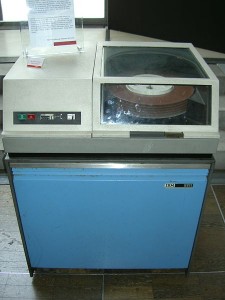 Let’s get one thing straight: IBM is responsible for much of modern enterprise computing, so it’s no surprise that when it comes to storage, they developed just about everything, including disk drives, floppies, tapes, arrays, and libraries. So why pick this particular piece of kit? Prior to 1964, computer components were developed as a set (the 350 storage system went with the 305 RAMAC, for example), but the 2311 changed that. It was a generic storage device, plug-compatible with a range of computers. If you claimed that the 2311 was the common ancestor of all modern enterprise storage, I would certainly agree with you!
Let’s get one thing straight: IBM is responsible for much of modern enterprise computing, so it’s no surprise that when it comes to storage, they developed just about everything, including disk drives, floppies, tapes, arrays, and libraries. So why pick this particular piece of kit? Prior to 1964, computer components were developed as a set (the 350 storage system went with the 305 RAMAC, for example), but the 2311 changed that. It was a generic storage device, plug-compatible with a range of computers. If you claimed that the 2311 was the common ancestor of all modern enterprise storage, I would certainly agree with you!
Other notable IBM products worth mentioning:
- The original 1956 RAMAC 350 disk drive unit
- The 1961 301, which used a separate arm and head for each platter (like every disk drive produced since)
- 9-track tape, which dominated from 1964 until the 1/2-inch tape revolution in the 1990s
- The 1970 3330, which added error correction and remained in production for 13 years
- The 1971 introduction of the 23FD floppy disk drive
- The 1973 3430, whose “30/30” code name caused people to refer to hard drives as “Winchesters”
- 1974’s 3830 “MSS” tape library
- The 1980 3380, which introduced film-head technology
- 2003’s SAN Volume Controller, the first successful SAN virtualization product (after many others failed!)
1976 Shugart SA-400 minifloppy
Alan Shugart’s floppy drive was a massive hit in the home computing market, but why include it in a list of enterprise storage technologies? Because its storage interface set the standard for plug- and protocol-compatible storage in the nascent microcomputer world.
Designing a general product for use in a multitude of systems was truly innovative, and many later computers were literally designed around both the concept and physical form factor of Shugart’s drive. Simply put, this fat floppy drive inspired computer designers to create computers that could accept standard peripherals, the very definition of open systems. The definition of “peripheral” would soon grow to include standard I/O devices like storage, terminals, printers, communications gear, and everything else we know today.
1980 Seagate ST-506
Shugart left his company in 1979, founding Seagate Technology. That company’s first product was the ST-506, a 5 MB hard disk drive that shared its physical shape with the SA-400 and used a similar interface.
Like the floppy, Shugart’s hard drive set the standard for microcomputers, eventually finding its way into enterprise systems, and catapulting Seagate to its current position of disk drive leadership. Higher-capacity derivatives of the ST-506 were fitted with interfaces using Larry Boucher of Adaptec’s SCSI protocol, which continues in use even today. Although the ST-506 wasn’t a “smart” drive, the ecosystem that developed around it was critical.
1984 DEC TK50
Digital Equipment’s introduction of the MicroVAX II in 1985 was accompanied by a new half-inch backup tape drive and cartridge called the TK50. Open-reel tapes had dominated non-disk storage before this, but cartridges quickly replaced reels, leading to the development of tape robotics and (more) reliable off-site storage.
If you picked up a TK50 tape today, you could be forgiven for mistaking it for a modern SDLT or LTO, because these use a similar cartridge and drive form factor, the same linear tape technology, and the same half-inch tape size. The TK50, DLT, and SDLT were the mainstays of open backup for decades.
1987 Auspex
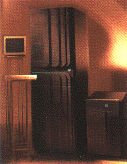
What was the first open systems enterprise storage array? Leveraging Sun’s NFS protocol, and hiding a Sun workstation inside, Wizard of Oz style, the Auspex set the standard for everything we think of as “enterprise” in the open systems world. The company’s storage systems were truly ahead of their time, with ranks of redundant disks years before RAID became common.
Auspex was founded by Larry Boucher, father of SCSI and founder of Adaptec, and raked in sales while others struggled to figure out how to sell in the enterprise. But their refusal to produce a smaller device would be their undoing. Today’s monolithic arrays owe as much to Auspex as they do to IBM, but the companies producing them could learn a lesson from the company’s demise.
1987 StorageTek 9310 PowderHorn
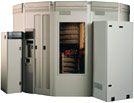
StorageTek was instrumental in many enterprise storage developments (see McData, for example), but one product literally transformed the datacenter: the 9310 “PowderHorn”. Consider the “glass house” datacenter tours that the largest companies would use to impress visitors: They would show off their mainframe, their Cray, or their PowderHorn.
This versatile system would accommodate every major tape cartridge format and system type and could scale to truly massive proportions. When disks were expressed in megabytes, PowderHorns held terabytes.
1995 EMC Symmetrix 3000
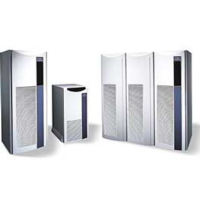
The 1990 introduction of the Symmetrix was the key turning point for the (now) giant of Hopkinton, but the first two generations were mainframe-only. In 1994, the company delivered data replication capability in the form of SRDF, moving key enterprise functionality to the storage array.
But it was the 1995 introduction of the third-generation Symmetrix 3000 that really changed the storage world. For the first time, open systems could connect to mainframe-class storage over the standard SCSI protocol and leverage features like SRDF and (in 1997’s Symm 4) TimeFinder.
One key ingredient often overlooked in the Symmetrix was in-box virtualization the likes of which hadn’t been seen before. It also featured RAID-like sub-disk data protection, though the Symmetrix line never did implement true RAID.
The Symmetrix was redesigned entirely in 2003 to become the DMX. Although it was as different from its predecessor as the New Beetle was from Volkswagen’s original, the DMX line continued many of the philosophical underpinnings set in 1990.
EMC also deserves credit for their original Celerra enterprise NAS system, which picked up where Auspex left off. The company followed these in 2002 with the Centera CAS system, which abandoned many traditional concepts of enterprise storage, like blocks- and filesystem-access and modular and monolithic architecture. The Centera is certainly innovative, but we have yet to see the impact it will have.
1994 Data General CLARiiON
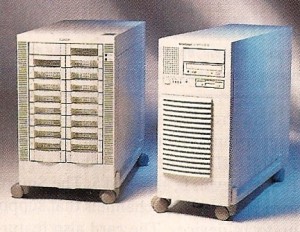
It’s easy to forget the world before RAID. But Data General was one of the first to market with a cached RAID system with their 1991 introduction of the HADA. Although this early system was tied to DG’s servers, it donated much of its architecture to a system that became more valuable than the rest of the company: CLARiiON.
Massively successful, and mighty impressive (PC Magazine called the first CLARiiON “amazing”), this modular block storage array set the template for over a decade. There were dozens of copycat arrays on the market within a few years of the introduction of the HADA. The CLARiiON gained Fibre Channel support, was sold to EMC, and remains a mainstay of corporate data centers, albeit with updates to every component. I have administered every generation of CLARiiON array, and can attest to their capability (when properly configured!)
1996 NetApp Multiprotocol Filer
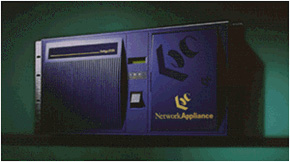
NetApp (nee Network Appliance) was formed by a group of ex-Auspex engineers who wanted to create a more modular NAS server based on industry-standard hardware. They released their first product, the NFS-only FASServer, in 1995, but it was their August, 1996 introduction of the Windows-compatible Multiprotocol Filer software that really put them on the map.
Combined with their solid F220, F330, and F540 hardware, NetApp now had a serious challenger to Auspex, and their NAS systems blew away dedicated server-based solutions in terms of flexibility and manageability. NetApp’s unified NFS, CIFS/SMB, and HTTP access to content on their unique WAFL file system was impressive at the time, as was the quick setup and administration and the ease of adding drives to their RAID-4 sets. Plus, they brought a new level of friendliness to the data center with their bright colors and silly “toaster” nomenclature.
1999 McData Fibre Channel Director
McData has an interesting history, beginning with Storage Technology (StorageTek), intersecting with IBM, bought and spun off by EMC, and lately acquired by Brocade. Although the company spent a decade developing various peripherals for IBM mainframe systems, their late-1994 introduction of a switching director for ESCON traffic would change the storage world. We take large-scale SANs and LANs for granted today, but McData’s director was astonishing when it was introduced: There were no words to describe it or its function at the time, and period press articles are puzzling!
EMC scooped the company up a year later, but McData was spun out in 1997, adding Fibre Channel support that same year. In the ensuing years, McData became the enterprise SAN “arms dealer”, supplying IBM and EMC with the ED-5000 and ED-6064 directors. I recall commenting at the time that Fibre Channel connectivity built around the McData director was the first Storage Area Network worthy of the name. McData went IPO in 2000 and was purchased by rival Brocade in 2006. McData’s director architecture survives and thrives today against fierce competition from Brocade, Cisco, and others.
Others To Consider
What would you have included in this list? Here are some honorable mentions that I wish I had room for:
- StorageTek “Aegis” L700 library
- Brocade “LOOM” 2xxx switches
- Adaptec SCSI HBAs
- Copan MAID
- EqualLogic iSCSI arrays
- EMC Centera
- HP EVA
- HDS USP
- Compellent Storage Center
Responses
Here’s a list of responses that others have posted:
See my posts on Gestalt IT for similar enterprise IT infrastructure commentary
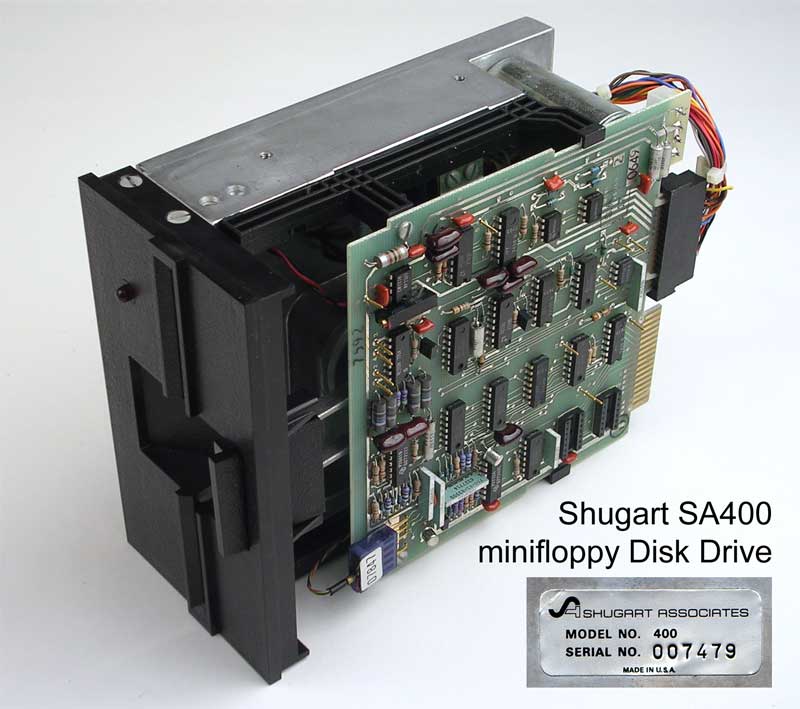
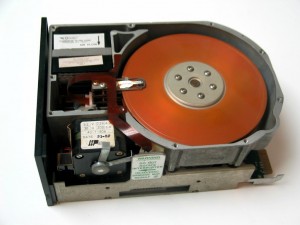
But Stephen, how could you have overlooked ‘s introduction of in ?
Clearly this list is not complete without ‘s .
Nice job – a great lineup of products., truly representative of the evolution of the industry.
One small point of clarification – today Symmetrix DMX’s do indeed support RAID 5 (and RAID 6).
And I totally agree with your decision to ignore in !
Not that I would DARE to correct Mr. Burke about EMC products, but the DMX doesn’t really do true RAID-5 since it still uses hypers rather than whole disks. Not that this is a bad thing, mind you – it’s actually very very sensible!
I have to disagree with your decision to ignore ‘s . Don’t forget that in , from claimed it was in its market.
Hnmmm…I failed to see that requirement in the definitions of RAID. But no matter, the fact is that for any given drive in a 7+1 set, ALL of the hypers on that drive must in fact be ONLY on one of the other 7 drives. Sure, you can also have 3+1, 1+1 and 6+2 hypers on that given drive, but all of their members must also be only on the same 8 drives.
So, if you create ONLY 7+1 RAID sets on a group of 8 drives, all the hypers will only be on those 8 drives, thereby matching the requirement that you defined for “TRUE” RAID 5.
No?.
Stephen,
I have a different take. I put this on Marc’s blog too – sorry for the redundancy – but isn’t that important in storage 😉
– Thin provisioning
– Data De-duplication
– Virtual volumes with large capacity pools
– Writeable snapshots
– Large, scalable file systems
– Storage virtualization – both the SVC and the USP-V
– Object-based storage (still not living up to its promise)
– Search and indexing of storage (also not living up to its promise)
– Clustered storage
– Global name space – having a single view and control of multiple file systems (also not living up to its potential)
– Spinning down drives – this makes it 11 but I do think this adds value and is innovative. We need to reduce power and cooling and this impacts that with backup and archived data.
Tony,
Excellent! I was planning “technologies” and “software” lists, and you’re right there with about half of each!
Except for thin provisioning! 🙂
Stephen
Tony,
Excellent! I was planning “technologies” and “software” lists, and you're right there with about half of each!
Except for thin provisioning! 🙂
Stephen
I have not much time, but I’ve got many useful things here, love it!
I have not much time, but I've got many useful things here, love it!
(1) LaserDisc (1978). First serious optical disk, way before CD-ROM. Yes, some people did use them for data storage. All optical technologies since embody lessons learned from LD.
(2) Fujitsu DynaMO (1992). Magneto-optical is one of my favorite bygone storage technologies. This plus the contemporaneous MiniDisc proved the viability of the technology, which for many years provided durability better than modern optical technologies at performance levels close to magnetic. Unfortunately it never escaped a spiral of high cost, low usage, and slow development. While MO itself is dead, its cousin HAMR carries on some of its legacy.
(3) IBM Deskstar 16GP (1997). First to use Giant Magneto-Resistive heads, which have since become ubiquitous.
(4) Seagate Momentus 5400.3 (2006). First to use perpendicular recording, likewise.
Xserve RAID and Xsan